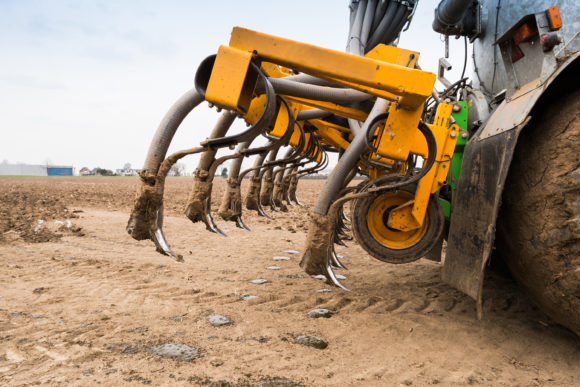Recent court and regulatory actions across the country with regard to environmental pollution exclusions in insurance policies have shown the need among farm owners and other agricultural risks for true environmental liability coverage tailored to their particular risks.
Insurance agents are well aware that virtually all property and liability insurance policies have some form of pollution exclusion. However, the reality that pollution exclusions are not limited to industrial operations sometimes comes as a surprise to both insurance agents and farm owners/operators alike.
As regulatory pressure grows and the insurance industry tightens up on pollution exclusions, farm owners and other agricultural risks could be left totally uninsured if they do not use the specialized environmental insurance coverage tools now available. This is particularly true as the environmental loss exposure for farms and other agricultural risks has changed significantly in the last few years.
Several recent cases in various jurisdictions serve to highlight the environmental risk factors faced by agricultural operations.
On Dec. 30, 2014, the Wisconsin Supreme Court in Wilson Mutual v. Falk determined that bacteria contamination in drinking water wells, as a result of spreading manure on fields, was an excluded cause of loss due to the pollution exclusion in the liability insurance policies commonly sold to farms. On the same date, the Wisconsin Supreme Court ruled in a separate pollution exclusion case, that nitrate contamination in groundwater was also an excluded pollution loss in liability insurance policies.
These ground breaking decisions at the state supreme court level set a precedent that pollution exclusions in insurance policies are, in effect, “contamination” exclusions.
In Iowa, the City of Des Moines is suing agricultural drainage districts that are owned by farmers in three counties north of the city. Des Moines is seeking to recover the costs of a new water treatment facility to remove nitrates from the water in the two rivers the city depends on for its drinking water supply.
It will cost the city $100 million to build a water treatment plant to deal with the agricultural-based contamination of the water supply. If Iowa follows the Wisconsin Supreme Court in determining that the general liability insurance policies sold to farmers do not cover contamination losses due to the pollution exclusion, in the absence of insurance the new $100 million water treatment plant project will be funded under the concept of “let the polluter pay.”
The stakeholders in the water districts being sued will likely be uninsured for any part of that $100 million.
In Washington state’s Yakima Valley, environmental groups for the first time were successful in filing lawsuits against three industrial dairy farms under the federal Resource Conservation and Recovery Act (RCRA), a federal law that governs the disposal of solid and hazardous waste, and the U.S. Clean Water Act.
The suit was filed over groundwater contamination of drinking water wells, which supplied drinking water to 24,000 residents in the Yakima Valley area. This was the first time in U.S. history where RCRA was applied to farm animals, and it was another first in which a federal court ruled that improperly managed manure was a solid waste, rather than a beneficial farm product.
The farms involved in the litigation were required by settlement to fund a residential bottled water system for safe drinking water for at least two years or until nitrate contamination was deemed no longer to be of significant volume. They also were required to pay for replacement, cleanup and monitoring costs going forward.
The contamination that arose out of everyday dairy farming activities was found to be harmful to human health. However, the farm owner’s business liability insurance policies included pollution exclusions that barred coverage for damage resulting from those substances.
Unavoidable Environmental Exposures
For example, due to historical farming operations nitrates commonly are found in drinking water wells located in farming communities. At low levels, nitrate contaminants in groundwater thought are not to cause harm. However, a spike in the level of nitrates can cause bodily injury, especially to infants, and as one of the Wisconsin Supreme Court cases illustrated, a spike could be fatal to a neighbor’s cows.
Specially modified environmental impairment liability insurance policies for farms are needed to address the fact that nitrate contamination of groundwater is a known preexisting pollution condition in most agricultural settings.
Below are some common and unaddressed environmental loss exposures of concern for farming and agricultural risks.
Common Uninsured Environmental Loss Exposures in Farming
- Groundwater contamination
- Surface water contamination
- Crop overspray
- Odors
- Reduction of neighboring property values
- Public nuisance
- Operating or participating in manure digesters
- Damage to natural resources
- Bodily injury from exposure to bacteria
- Groundwater remediations
- Fuel storage tanks
- Fertilizer spills or releases
- Custom farming operations
- Transportation risks
- Storage of pesticides and herbicides
Environmental Insurance Coverage
While environmental insurance for industry has been available since the late 1980s, environmental risks particular to farm and agricultural operations have not always been addressed. As a result, environmental excess and surplus lines insurance markets have developed specialized farm environmental insurance products and programs to address the specific environmental loss exposures faced by farms and agricultural risks.
Environmental insurance policies are designed to fill the coverage gaps in property and liability insurance policies created by pollution exclusions. However, there are no insurance industry standards for environmental insurance policy design, or for the actual insurance coverage these insurance policies provide. Therefore, it is necessary to properly match the environmental policy to the needs of a particular insurance buyer.
For example, older environmental insurance policies and limited pollution liability endorsements once meant for manufacturers or construction firms covered sudden and accidental contamination events. Such coverage is worthless for farming risks, because actions like spreading manure and increasing nitrate and phosphorous levels for better crop yields are not sudden or accidental, but intentional operations of the farmer.
These factors, combined with changes in the liability insurance coverage currently sold to farmers, all work together to create a demand for the purchase of specially modified environmental insurance for the family farm and other agriculture risks.
Insurance agents and brokers are encouraged to seek out expertise when procuring specialized environmental insurance placements, as coverages and how they can be impacted by the multitude of federal and state environmental protection laws can get tricky.
Topics Legislation Agribusiness Pollution
Was this article valuable?
Here are more articles you may enjoy.



 Abundant Reinsurance Capacity Accelerates Market Softening During 1/1 Renewals
Abundant Reinsurance Capacity Accelerates Market Softening During 1/1 Renewals  2 New Jersey Pilots Killed in Helicopter Collision Frequented Nearby Cafe Together
2 New Jersey Pilots Killed in Helicopter Collision Frequented Nearby Cafe Together  Cloudy Future for Bourbon Has Jim Beam Closing Distillery for a Year
Cloudy Future for Bourbon Has Jim Beam Closing Distillery for a Year  Aon Extends Employment Agreement With CEO Case
Aon Extends Employment Agreement With CEO Case 


